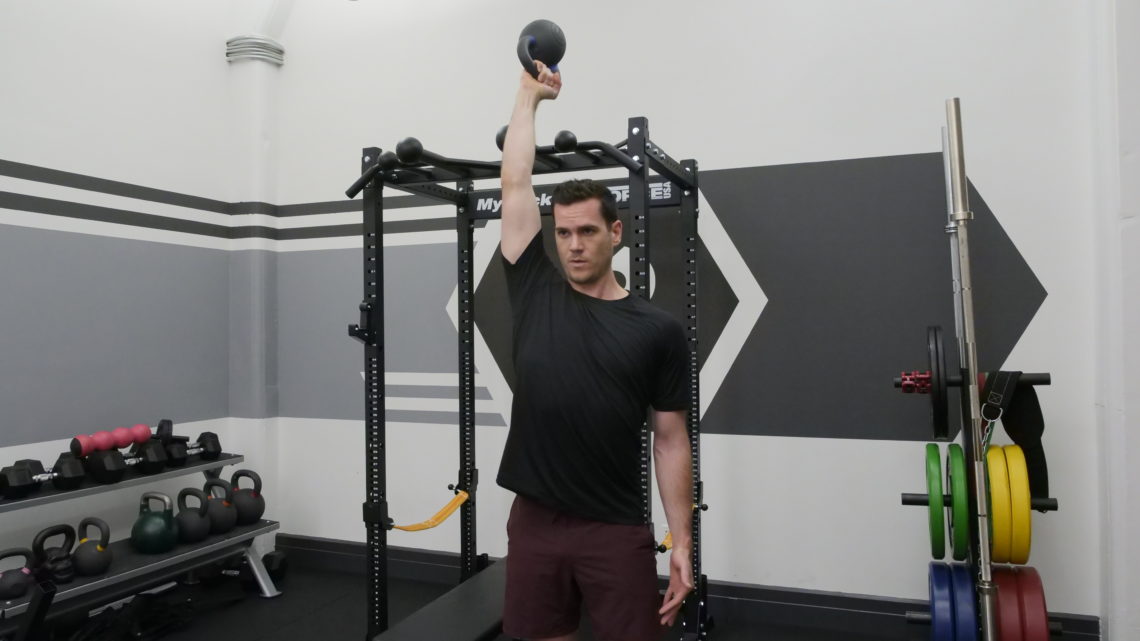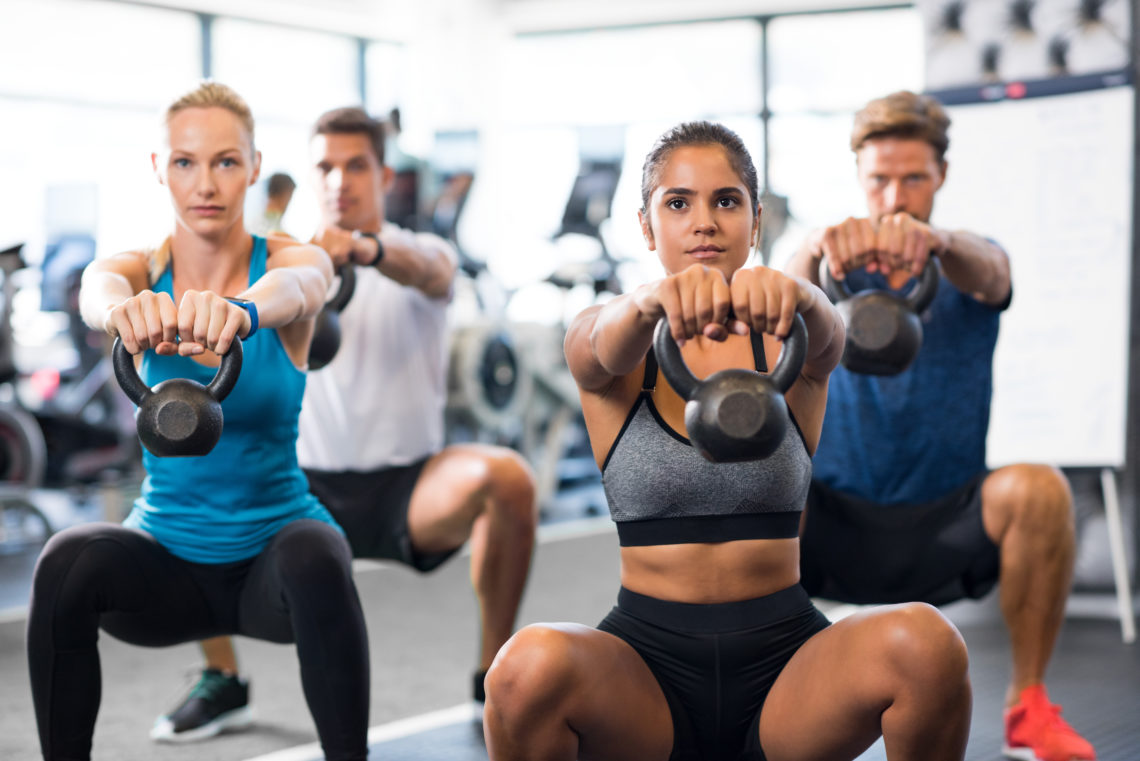Congratulations — you were able to snag one of the last kettlebells from your favorite fitness outlet before they all sold out. The only problem is, you had no choice but to get a bell that’s pretty light. And while that can be great for your upper body, which generally requires less weight for maximum stimulus than your lower body, you might be stuck wondering how to train your legs with a light kettlebell.
The good news is that you don’t have to crank out hundreds of reps at a time to build your lower body. Even if all you have is a light kettlebell, it’s about training smart (as always). If you get creative enough with your moves — and your tempos — you’ll be able to maintain leg strength and muscles even with minimal equipment.
A light kettlebell might not be helpful for overloading your back or front squat, but as long as you can maintain your movement patterns — and improve your mobility — you’ll be able to bounce back in the gym in no time. Fortunately, a light kettlebell and some creative thinking can help you get there.
But having the moves alone isn’t enough. Sure, you’re working with a light kettlebell, but don’t let that tempt you to blow through the movements without any thought or discipline. Treat each lift like you were handling a heavy weight, keeping your core braced and body tight throughout each movement. Unless you’re deliberately doing something plyometric, keep your movements slow and controlled. The more you train your body (and mind) to attack heavier weights, the more effective your training will be.

Unilateral Romanian Deadlift
- With your (light) kettlebell in your left hand, square your hips and focus on keeping them squared throughout the entire movement.
- Hinge at your hips, sending one leg back behind you (as straight as possible, or with a soft bend in the knee) and keeping one leg planted in regular old deadlift position.
Play around with what you’ll feel most balanced doing (it’s more important to be comfortable with balance than to jump right to what’s more challenging) — you might decide that with the bell in your left hand, you’ll plant your right leg and send your left leg back, or you might find it more stable to plant your left leg and send your right leg back. Whichever you choose, make sure you keep your positioning consistent.
No need to bring the bell all the way to the ground here — hinge back up when you feel a stretch in your hamstrings (or, if your hamstrings are super flexible, stop when the bell is at about your shin level). Gently tap the floating foot when you’re standing upright to regain your balance, and repeat.
Training Recommendation
4 x 12 slow, quality reps per side.
Bonus Variation
Don’t tap your foot for balance between each rep — keep one foot off the floor the entire time.

Front Rack 1.5 Bulgarian Split Squat
- With such a light bell, it shouldn’t be hard to set up in a unilateral front rack position.
- Don’t be tempted to let your core go slack, though — just because it’s a light weight doesn’t mean you shouldn’t be training like it’s heavy.
- Brace your core and find your footing, using trial and error to figure out how far you should be from your chair, couch, or bed to set up your Bulgarian split squat.
- Set your back foot’s laces down on your stable surface of choice and shimmy until you can get into a crisp, knee-tracking-over-toes lunge with your front leg.
- You don’t have to bring your back knee to touch the floor, but you do want to go down far enough to get a good stretch in your back leg, and your front thigh is nearly or at parallel with the floor.
- Keep your torso as upright as possible.
Sink down into one complete rep, and then here’s the 1.5 part: rise out of the split squat only about halfway, then sink back down to bottom position. Only then, after 1.5 reps, will you stand, reset, and consider yourself done with a single rep. This kind of rep scheme is particularly evil with Bulgarian split squats — so much so that even a light kettlebell will feel like a lot.
Training Recommendation
3×8 full 1.5 reps per side.
Bonus Variation
Slow the reps down so you’re taking a full pause at the bottom of the split squat and again at the 1.5 mark.
Like this, but you’re not getting back up to standing between reps.
Sumo Iso-Squat Calf Raises
Let’s break this down:
- Sumo — set up in a wide squat stance (make sure it’s not too wide that you can’t squat with good form, knees tracking over your toes, torso relatively upright).
- Iso — stay in the bottom of your sumo squat position during the entire duration of each set.
- Calf raise — stay in the bottom of your sumo squat, and… do calf raises. AKA, rise up on your tiptoes, but don’t actually stand up.
- Keep your thighs relatively parallel to the floor throughout your entire set of calf raises.
You’ll be working your quads, glutes, and calves, not to mention your stability, the entire time.
As for your kettlebell, use both hands to hold it at chest level, like you would with a heavy goblet squat. With your calf raises, make sure to go slow (even though your quads will be telling you to hurry up and go fast). Make it a goal to count a slow one chimpanzee, two chimpanzee on the way up, and a slow one chimpanzee on the way back down out of each calf raise rep.
Training Recommendation
4×15
Bonus Variation
Hold a strong contraction at the top of each calf raise (still in an iso-squat position) for a full three seconds per rep.
Front Rack Lateral Lunges
- Start with the bell in front rack position in your right hand with your feet close together.
- Step your right foot out to the side, wide enough so your knee will track over your toes but close enough that you can send your hips back so you’re sitting fully down into the lateral lunge.
- Bring your right foot back to starting position to reset after each rep.
- Repeat with your left side.
You’re lunging, except you’re going to work in the frontal plane (side-to-side), which — just get it over with and admit it — you totally neglect when you’re actually in the gym.
Because this is a movement pattern you probably don’t do nearly enough of, a light weight should be enough to give you a fairly decent workout.
Training Recommendation
3×12 per side
Bonus Variation
Pulse your reps — keep your feet in the same position throughout your entire set (without coming back to center to reset between each rep)
Like this, but with a kettlebell overhead.
Overhead Reverse Lunges Into Front Kick
- Press the bell overhead with your right hand, pack your shoulder, brace your core.
- With your feet a little closer than hip-width apart, send your right foot back into a reverse lunge.
- Keep your elbow locked and the bell directly overhead.
- With control, complete the reverse lunge, bring your right foot back to center, but don’t put it down — instead, transition into doing a front kick with your right foot.
- Then bring your foot back to center and repeat.
When you complete your sets on the right side, press the bell overhead with your left hand, send your left foot back into a reverse lunge, kick, and repeat.
Training Recommendation
3×12 per side
Bonus Variation
Add a pause — when you transition into your front kick, bring your thigh up to parallel with the ground and then pause before you extend your leg to kick outward from your knee.
Unilateral Overhead Lunges
- Similar in setup to the overhead reverse lunges, you’ll press the bell overhead with one hand, lock your shoulder, brace your core, and then… lunge.
- Complete your reps with steady control, bringing your back knee down to touch the ground (or almost touch) with each rep.
- Keep your torso upright and don’t forget the whole breathing thing. Switch hands and repeat.
Training Recommendation
4×10 per side
Bonus Variation
Complete the same movements with the bell pressed in a bottoms-up position (literally, the bottom of the bell facing the ceiling).

Unilateral Overhead Squat (Bottoms-Up Variation)
- Press the bell overhead once again — but instead of packing your shoulder, with your upper arm close to your ear, feel free to let the bell deviate out to the side a little bit.
- Because you’re going to settle into an overhead squat.
- This will do wonders for your lats as well as your lower body — the extra discipline your lift will need to manage a weight unilaterally pressed overhead will tax your entire body more than you’re used to from a traditional squat.
Training Recommendation
3×6-10 quality reps per side
Bonus Variation
Complete the same movements with the bell pressed in a bottoms-up position (literally, the bottom of the bell facing the ceiling)
Like this, but holding a kettlebell on your belly button.
Weighted Single-Leg Glute Bridge
- Lay on your back with bent knees and both feet on the floor.
- Hold your kettlebell with both hands underneath your navel (with whatever grip is comfortable for you.)
- Drive your traps into the ground and squeeze your glutes to hinge your hips up as far as they’ll go.
- Straighten your left leg and begin the first rep, sinking your hips low near the ground and then back up.
- Keep your left leg straight and as parallel as you can make it with your right thigh throughout the set. Switch legs and repeat.
Single-leg glute bridges are usually reserved for “if we remember” territory, but it’s always a good time to bring these back into our repertoire. By engaging your glutes and hamstrings, you’ll be sure to come back with a strong hip hinge. And making the movement unilateral — by straightening one leg so that your lower body weight is supported only on your bent leg — will challenge your balance.
Training Recommendation
4×10 per side
Bonus Variation
Instead of keeping the bell close to your body, press it up toward the ceiling and hold it there throughout your sets.

Arms Out Pause Squat
- When you’ve sunken into your pause squat position, press the kettlebell out away from your body (AKA your arms straight out in front of you).
- Keep your chest tall and hold that isometric squat for as long as you can, and that’s one set.
Don’t squat all the way down into the hole, though. If you’ve got the ankle mobility to squat all the way down, it’ll actually be easy to stay there for an isometric hold. If you rise out of your deepest squat slowly, you’ll find that spot where your muscles are most engaged (at or just above parallel for a lot of people). Find that spot for you — your pause squat position — and sink into it with your core engaged and both hands holding the kettlebell by your chest.
Training Recommendation
4 sets to failure
Bonus Variation
Maintain your isometric squat, but actively press the bell toward and away from your body.
Squat Jumps
- By holding a kettlebell at chest height with both hands, even a light bell will up the ante of regular old squat jumps.
- If you live above neighbors, place special emphasis on landing extra softly — this might slow your reps a little, but it’ll actually be good for your gains.
- Landing extra softly will give your calves some extra work to do, and it’ll force your body to explode with even more power with each rep.
Plyometrics are a great help when you’re trying to maintain muscle mass and build muscle on top of that.
Training Recommendation
3 x AMRAP (as many reps as possible) 45 seconds
Bonus Variation
Throughout your sets, hold the bell out in front of your chest with straight arms, instead of hugging it closer to your chest
Light Weight, No Problem
You don’t need to lift heavy to lift effectively. Don’t get me wrong — I miss heavy barbells more than a kid misses summer vacation when they’ve got a looming algebra exam. But if it’s your gains you’re worried about, even a light kettlebell can help you build your lower body so you’ll be prepped and ready to go back to your gym with a vengeance.
The post 10 Lower Body Exercises for When You Only Have a Light Kettlebell appeared first on BarBend.

